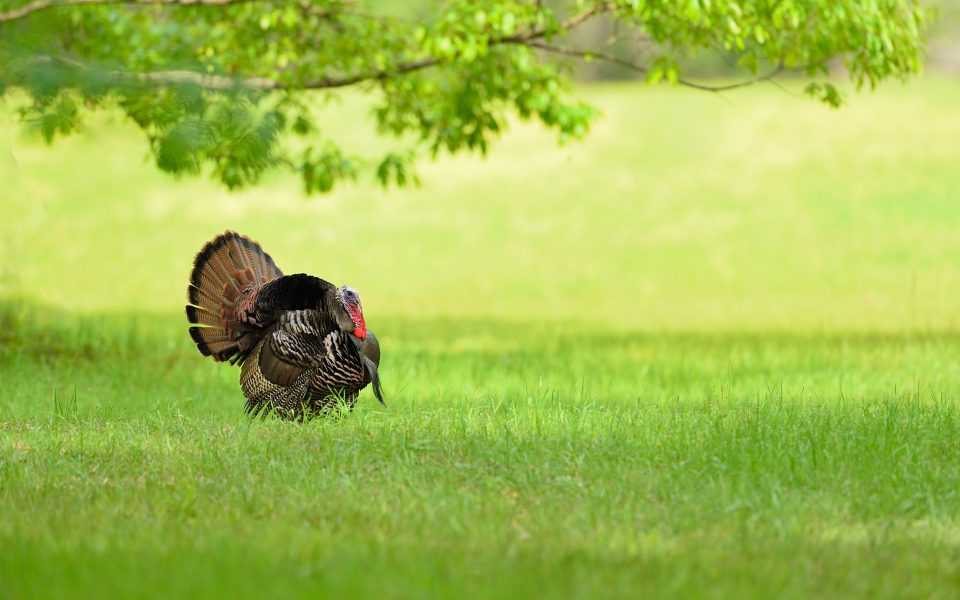On heavily hunted private and public lands, two days after the opening of turkey season, mature gobblers have heard just about every turkey call that’s ever been made. They might even be able to tell you the call maker’s name. As turkey hunters, we try to pattern turkeys to understand where they’ll be and when they’ll be there. However, we often forget that turkeys pattern turkey hunters, too. They learn when we’ve invaded their turf, and when we’re not in the woods. We teach gobblers when they are least likely to catch a load of lead to the head.
Rainy Day Turkey Hunts
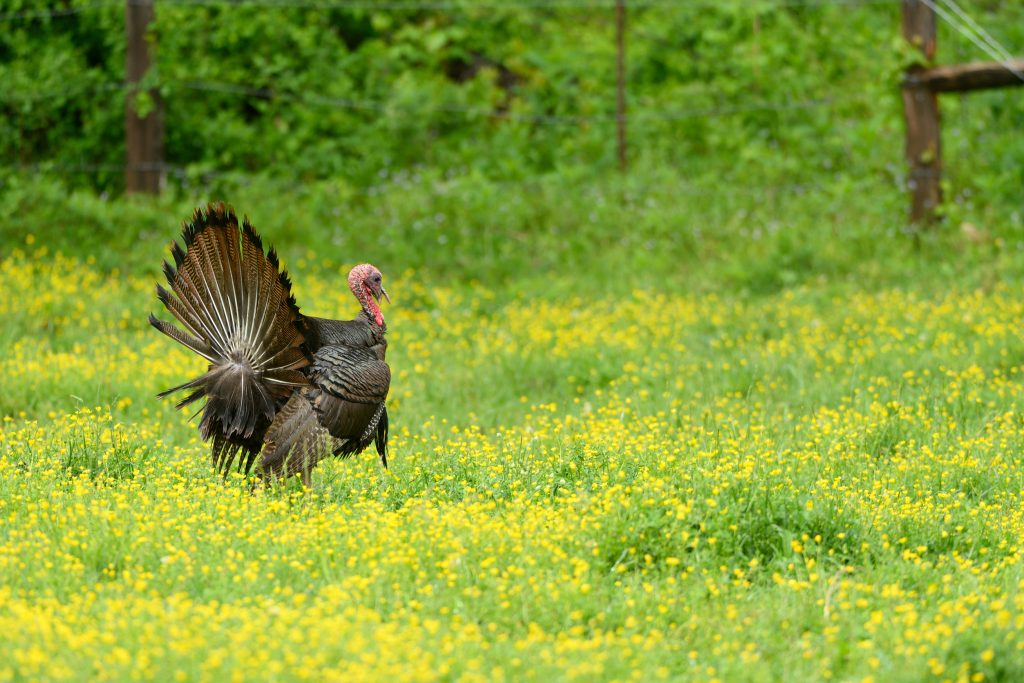
Tes Jolly
Since most turkey hunters dislike hunting in the rain, it seems toms feel secure on rainy days. They are often much easier to call in than on other days, especially if you know where they’re roosting and can get close enough to call them when they’re on the roost.
After toms leave their roosts on rainy days, they’ll move to open fields, pastures, clear cuts and any other big openings. Then they can see danger coming from a long way off and don’t have to walk through wet foliage. If you set-up on the edge of a field where a gobbler’s strutting, drumming and entertaining hens, you may call him close enough to take him.
On one hunt, I’d been sung to sleep by rain dancing on the roof and had snuggled down in my warm sleeping bag, when in the darkness, Mark Drury punched me and said, “Come on, John. We’ve got to go get you a turkey.”
I couldn’t believe what I was hearing, and I said, “Mark, the rain’s pouring down.” Mark answered, “Yes, a tom won’t be able to see us or hear us, and if everything works out right, we should be back in camp in about two hours or less.”
I rolled out of my bed, put on my long underwear, camo clothing and rain suit, but couldn’t believe I was going out in the pouring down rain. This rain was one that you’d stand at a window, looking out and saying to yourself, “I’m glad I’m not out in that!”
After grabbing a quick snack and not even taking time for coffee, Drury and I left the protection of the warm camp house, climbed in his truck, drove for about 30 minutes and disembarked in a driving rain. Still baffled about why we were doing this, I walked with Drury for about 30 minutes down a muddy dirt woods road before he whispered, “Okay, John. From here on out be really quiet. There’s a green field in front of us, and this turkey is roosting on the edge of that green field. We’re going to get in the woods at the end of the field and set-up, just inside the tree line.”
As the morning sun pushed away the black darkness, I heard a tom close by gobble. After the bird gobbled once more, Drury slapped his leg several times quickly to make the sound of a hen flying out of a tree. Then he scratched in the leaves, and with his mouth diaphragm began to cluck and purr as the tom kept on gobbling. Ten minutes later, the longbeard flew out of the tree and landed right in front of us at the end of the green field. Drury whispered, “Shoot him.”
My 2-3/4 inch 12 gauge reported and sent the shot through the rain to the turkey’s head. Drury quickly was on his feet and running toward the bird, yelling to me in the driving rain, “I told you we’d get you a turkey this morning.”
Once we had the gobbler in hand, we walked back to the truck and returned to camp. I asked Drury then, “Why in the world did we go out this morning instead of waiting for the rain to stop?”
Drury told me, “John, I roosted that bird last night. I knew right where he was. I knew that the turkey wouldn’t expect a hunter to come out in the pouring-down rain. That bird was more surprised than you were when you squeezed the trigger. The easiest way to take a gobbler is to be where he doesn’t expect you to be at that time and under the conditions that you’re hunting.”
Sissy Owling Gobblers
 I was hunting with the late Dick Kirby, the founder of Quaker Boy Calls, in Florida, one year. I arrived at camp late in the afternoon. Kirby told me, “Get your camo on, John. I want to go roost a turkey.” We drove for about 30 minutes, got out of the truck and walked about 20 minutes to the edge of a field. “A gobbler’s over there on that hill,” Kirby said.
I was hunting with the late Dick Kirby, the founder of Quaker Boy Calls, in Florida, one year. I arrived at camp late in the afternoon. Kirby told me, “Get your camo on, John. I want to go roost a turkey.” We drove for about 30 minutes, got out of the truck and walked about 20 minutes to the edge of a field. “A gobbler’s over there on that hill,” Kirby said.
Remember that a hill in the state of Florida may only three to four feet high. Kirby did some of his best owl hoots followed by a coyote howl, but that gobbler’s lips were locked. I could tell Kirby was getting frustrated. I told him, “I can make that tom gobble.” Kirby looked at me like I had three eyes and two heads and asked, “What are you going to do?”
I answered, “I’m going to put the sissy owl on him.” Kirby then said questioning, “The sissy owl?” I said, “Yeah, watch.”
I’ve been known to do some crazy things before to surprise turkeys and make them gobble, and making the sissy owl call generally is my last resort tactic. I cupped my hand to the side of my mouth and gave a high-pitched, not very masculine-sounding owl call. That bird doubled gobbled and triple gobbled. Kirby had to put his hand over his mouth to keep from laughing out loud. Once he got control of his laughter, I whispered, “You want to see me make him gobble again?” Kirby couldn’t speak and only nodded, “yes.” I gave another sissy owl call. Once more that turkey gobbled and gave up his position. Then we knew we could hunt him the following day.
The next morning, we used our binoculars to search for the gobbler on the roost, as he waited and watched for his hens to gather before he flew out of the tree. The tom helicoptered down and landed in the middle of his lady friends. We noted the direction the gobbler moved with his harem. That afternoon, before fly-up time, we got between the gobbler and his roost tree and “brought him home to supper with us.”
Cutting and Running Turkey Hunting Technique
Some years ago, a turkey hunting technique called “cut and run” became extremely popular. The premise of this strategy was to cover vast amounts of ground and give excited yelps and cuts to try and trigger a longbeard to gobble. After all, if you cover enough ground you’re bound to run into an active tom.
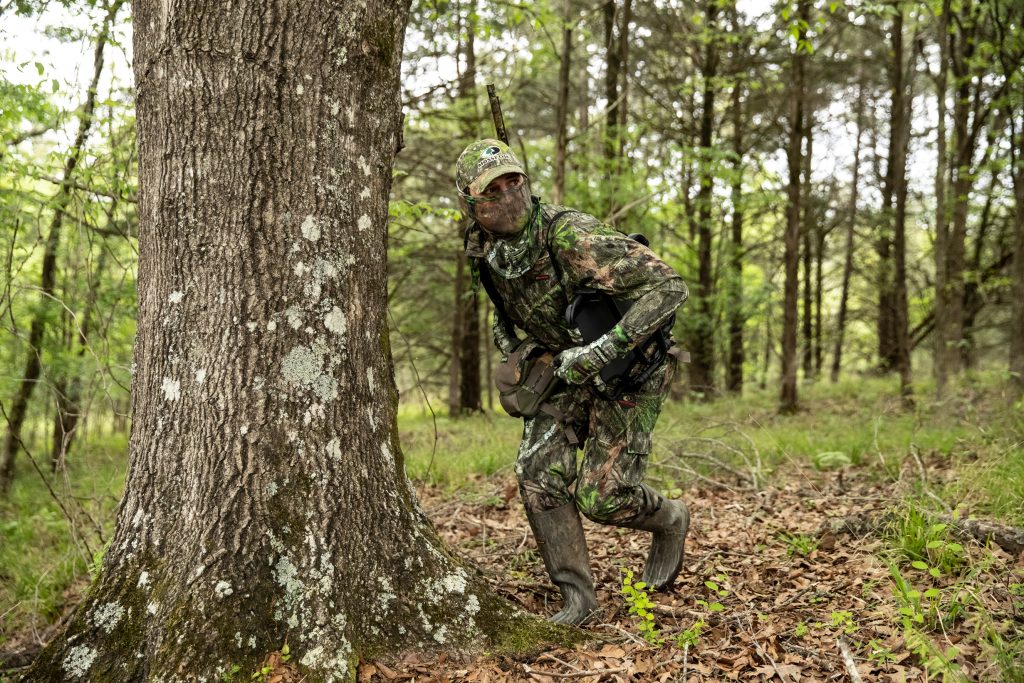
Turkey hunters learned from this method that in states where they could hunt all day long, many turkeys would gobble best between 11 am and 2 pm, which was lunchtime for many turkey hunters. Also the turkey hunters who had to go to work would have left the woods by then. Later in turkey season, the hens might be gone to the nest at that time, making finding girlfriends harder. Therefore, when a gobbler heard an excited hen in the middle of the day, often he wouldn’t be reluctant to go to her.
I’ve been on several hunts before where we slept in until later in the morning, didn’t go out to hunt until 10:00 am and found that the toms were much more active between 11 A.M. and 2 P.M. than they had been during the earlier morning hours. You could surprise them by calling then, and many times you’d have a short hunt and leave the woods with a bird on your back.
Hunting Little Spots Late
Scott Dillon, a longtime guide at White Oak Plantation, and I had hunted together all morning long but hadn’t heard a bird gobble. We were returning to camp when Dillon pulled his truck over to the side of the road after crossing a bridge over a small creek. “I’ve got a place down here that won’t take us but about 15 minutes to hunt,” Dillon said. “Often at the end of the season, turkeys will move into thick cover. There’s one little open spot just up from this creek where the gobblers often will strut and drum in the middle of the day. Let’s go give it a try.”
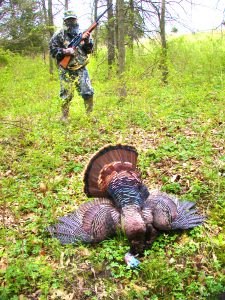
John Phillips
We bailed out of the truck, crossed the road, went down to the creek, walked along the edge of the creek and then moved quietly through some thick cover to a small opening not more than 30 yards in circumference. After letting the woods settle, Dillon gave three soft yelps. The woods exploded with gobbles. “They’re here, get ready!” Dillon told me.
In less than 15 minutes, three longbeards strutted in front of me. “Pick out one of those, John, and we’ll go get lunch,” Dillon told me.
When what I thought was the dominant bird dropped his strut, I squeezed my trigger, and that ole bird hit the ground. Once I returned to Dillon’s truck, I asked, “How did you know those turkeys would be there?”
Dillon told me, “At the end of the season, when turkeys have been pressured like these birds have, they’ll often move into thick cover because they’ve learned there’s less danger in thick cover than in open woods. However, they still want to breed hens. I don’t ever hunt that spot until the end of the season. More than a few times, it’s produced a longbeard because the turkeys aren’t expecting a hunter to be in that little bitty place.”
I called Dillon after turkey season had ended. I asked him about how many turkeys he’d guided hunters to, and he laughed and said, “I went back to that little place by the creek two other times. My hunters bagged two longbeards. The real secret to taking these turkeys, John, was to be where they didn’t expect me to be when they didn’t expect me to be there.”
Understanding Turkey Time
One of my best turkey-hunting buddies for many years was the late Bo Pitman, who guided turkey hunters for more than 20 years every day from March 15th until the end of April in Alabama. “Get you some snacks and a bottle of water before leaving camp because we’ll be hunting on turkey time,” Pitman told me.
When I asked Pitman what turkey time was, he explained, “When we leave camp, the turkey determines where we’ll go and when, what we’re going to do, how long we’ll hunt and when that turkey will allow us to return to camp. The tom dictates the hunt, and we just try to catch up to him.”
A classic example of hunting on turkey time was the “Middle-of-the-Road Turkey.” Pitman and I had hunted all morning long and had two gobblers to work. But those birds didn’t want to come to us. We were walking a red clay road back to camp that went up a little hill and had a high 4-foot bank on the right side of the road. Before we reached the top of the hill, Pitman took out a slate call and made three yelps. A turkey gobbled so close to us that he nearly blew our hats off.
“Get down, get down, get down!” Pitman “screamed” at me in a very hushed voice. We had no cover, and we were both lying in the middle of the road, with Pitman about 15 yards ahead of me. I felt as naked as I did on the day I was born. I realized that gobbler was right on top of us, and I had no idea if I’d be able to see the bird and take the shot before he spotted me or Pitman.
The turkey gobbled again, right above me on the little hill right in front of me. I got my gun to my shoulder and waited. Then I saw the gobbler. Although he was only about 10 yards away, he was standing beside a small sapling that covered his head and neck area. I didn’t have a shot.
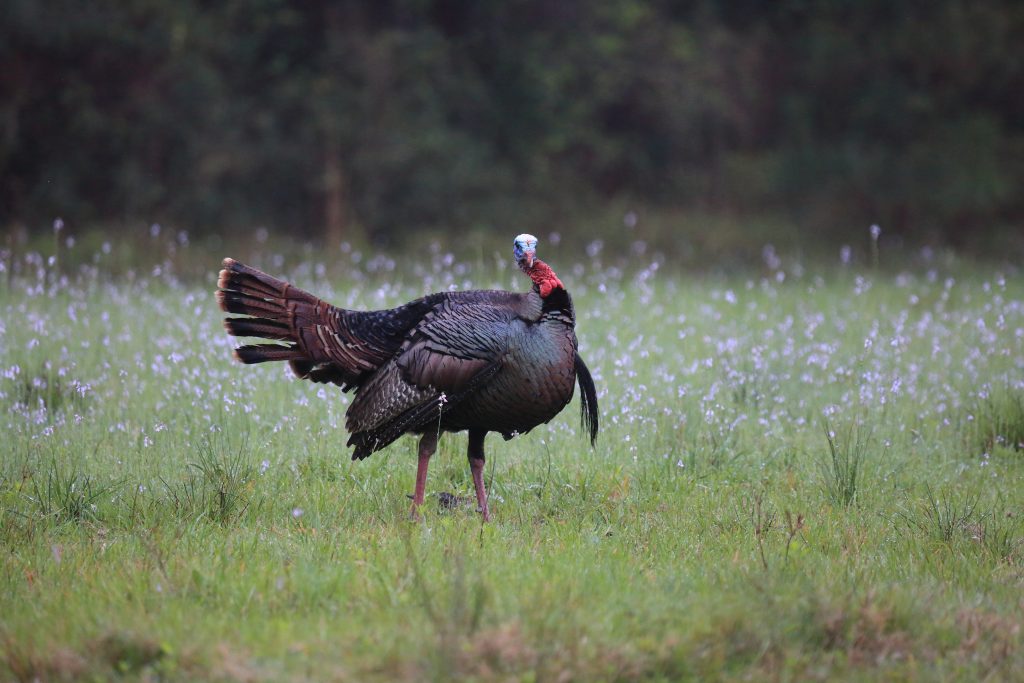
John Phillips
I waited and waited. Pitman was mouthing, “Shoot him, shoot him, shoot him!” to which I mouthed back, “I can’t!” For what seemed like an eternity, I watched and waited for that longbeard to take one step out in front of the sapling. Finally, the bird made that fatal move, and I was able to squeeze my trigger.
This hunt took place during the middle-of-the-day on a walk back to camp to eat lunch. I’d never been that close to a turkey when he gobbled for the first time. I’d never been in a worse position to take a gobbler than when I was lying on my stomach. However, Pitman and I were in a place that the turkey didn’t expect us to be at a time.
Killing A Friend’s Gobbler (That You’ve Not Really Hunted)
My longtime writing mentor and one of my best hunting buddies is J. Wayne Fears. We’d been invited to hunt Rio Grande turkeys in Texas. After hunting separate places, we met at 1:00 P.M. to walk back to camp together. We heard a turkey down in a bottom gobble on his own.
Fears announced, “I’ll go to him.” I said, “Okay, I’ll sit up on this hill, listen to the hunt and get together with you after you take the gobbler.”
Fears called the tom and almost had him to within gun range. But then I heard the turkey leaving Fears for some reason and coming up the hill toward me. I made a few soft yelps and a cluck. I was sitting by the only tree bigger than my shoulders on the entire hill. I watched the longbeard move to within 30 yards, and then I squeezed my trigger.
In a few short minutes, Fears came up the hill yelling, “You shot my turkey! You called him off of me, and you shot my turkey!” I explained that I’d heard the turkey leaving Fears and coming up the hill. I just gave the bird a little encouragement to drift my way.
“No, no, no, you called that turkey off of me!” Fears said.
To this day when we sit around a campfire, one of Fears’ favorite stories to tell is “the day John called a big gobbler away from me.” During this midday hunt. I was in a place that the turkey felt comfortable to walk in, and he never saw me.
If you can be where a longbeard wants and when he doesn’t expect you to be there, you may be able to surprise him and take him home with you.

